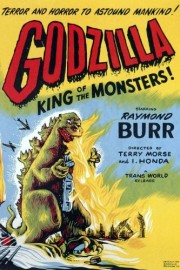Godzilla, King of the Monsters!
The first version of “Godzilla” I ever saw was not the awful 1998 Roland Emmerich lizard or any of the endless sequels and monster mash-ups, but this 1956 adaptation of the film produced by Joseph E. Levine. It wasn’t until I finally saw the original Japanese film a few years ago that I realized what I was truly missing out on. With 40 minutes cut from Ishiro Honda’s haunting masterpiece, and an American perspective grafted on with the addition of scenes featuring Raymond Burr (looking like Chris Christie) as Steve Martin (yes, really), an American reporter in Japan, this is a tragic bastardization of a film that was bold and powerful in post-WWII Japan, as well as the first hint of what was to come for Godzilla in future iterations. It’s hard to imagine any of Toho’s Godzilla movies being quite as appalling as this is, though.
The film centers of Burr’s Martin, and tells the story through his eyes, as he has made his way to Japan to visit a friend, and finds himself with a front row seat to the carnage and destruction brought about by the prehistoric Godzilla, who was brought to life by nuclear testing (although that context, and the central metaphor of Honda’s original social and political commentary, has been excised here). I now want to rewatch Honda’s film to see just what, and how much, was cut to see the differences, but the tonal disparity between the two films is all I need to know how this falls short. If you have only watched this film, with its new scenes directed by Terry O. Morse, you haven’t truly seen “Godzilla,” and you are simply watching a big, dumb monster movie. (I would even wager it’s a toss-up as to whether this film, or Emmerich’s, does more disservice to the source material. Who am I kidding, though- at least this film has the iconic man-in-suit look of Godzilla.) There really is very little to say about this version of the film other than to emphasize how much it misses the mark of why the original version was better. As an American viewer, I am so much more disengaged by this film than I was the original Honda film, which took me by surprise with its stunning beauty and pain. This film, despite some truly poignant moments when Godzilla is destroyed by a scientist’s deadly “oxygen destructor” device, is an example of needlessly messing with a masterpiece for the point of financial gain, while missing the point of why it was a masterpiece to begin with.










